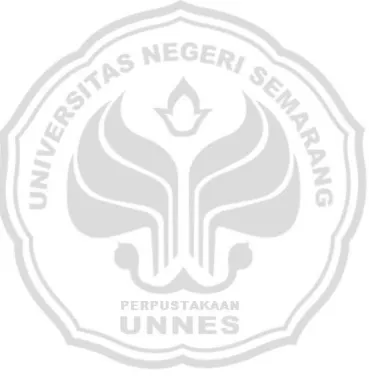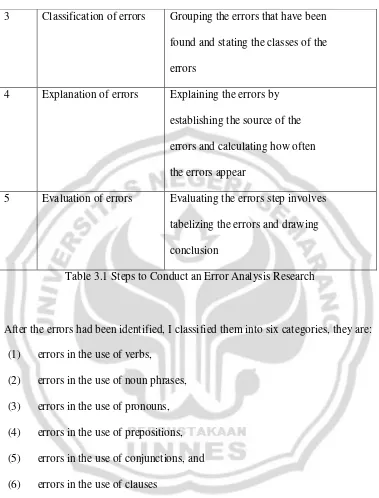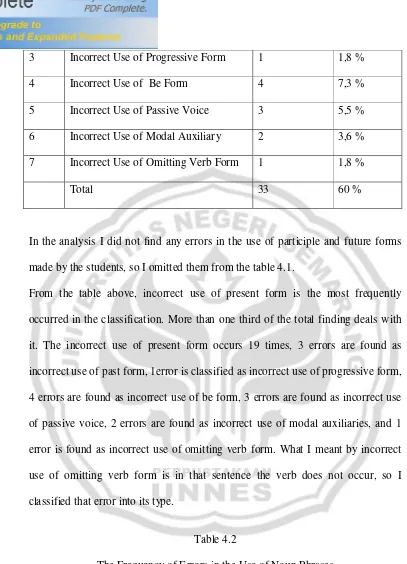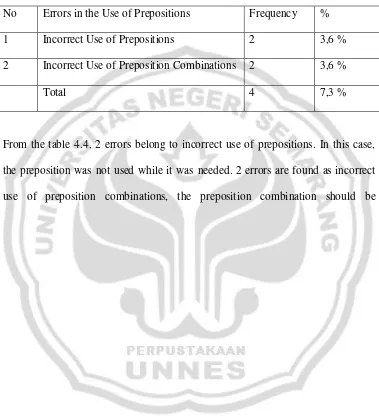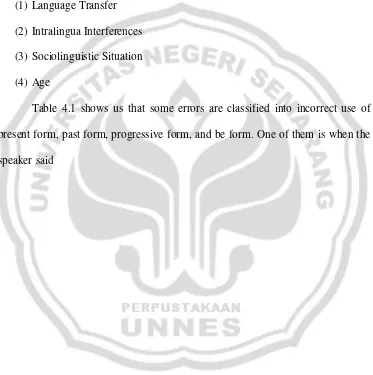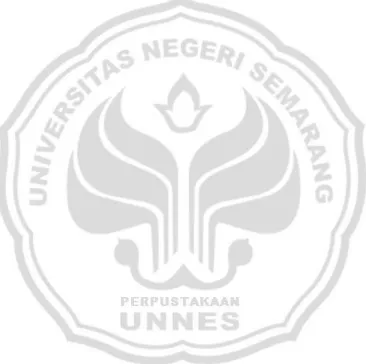AN ANALYSIS OF GRAMMAR USED
IN NON ENGLISH IMMERSION CLASSES
BY THE STUDENTS OF SMA NEGERI 1 PATI
a final project
submitted in partial fulfillment of the requirements for the degree of Sarjana Pendidikan
in English
by
Ratih Wahyuningsih 2201407150
ENGLISH DEPARTEMENT
FACULTY OF LANGUAGES AND ARTS
SEMARANG STATE UNIVERSITY
ii
APPROVAL
This final project was approved by Board of Examiners of the English Department of Faculty of Languages and Arts of Semarang State University (UNNES) on September, 2011.
Board of Examiners 1. Chairperson
Drs. Januarius Mujianto, M. Hum. NIP. 195312131983031002
2. Secretary
Dr. Dwi Anggani Linggar Bharati, M. Pd. NIP. 195901141989012001
3. First Examiner
Puji Astuti, S. Pd., M. Pd. NIP. 197806252008122001
4. Second Advisor as Second Examiner Intan Permata Hapsari, S. Pd., M. Pd. NIP. 197402242005012001
5. First Advisor as Third Examiner Drs. Suprapto, M. Hum
NIP. 195311291982031002
Approved by
The Dean of Faculty of Languages and Arts
iii
PERNYATAAN
Dengan ini saya:
Nama : Ratih Wahyuningsih
Nim : 2201407150
Prodi/ Jurusan : Pendidikan Bahasa Inggris/ Bahasa dan Sastra Inggris Fakultas : Bahasa dan Seni Universitas Negeri Semarang
menyatakan dengan sesungguhnya bahwa skripsi/ tugas akhir/ final project yang berjudul:
AN ANALYSIS OF GRAMMAR USED IN NON ENGLISH IMMERSION CLASSES BY THE STUDENTS OF SMA NEGERI 1 PATI
yang saya tulis dalam rangka memenuhi salah satu syarat untuk memperoleh gelar sarjana
ini benar-benar merupakan karya saya sendiri yang saya hasilkan setelah melalui
penelitian, pembibingan, diskusi, pemaparan atau ujian. Semua kutipan baik yang
langsung maupun sumber lainnya telah disertai keterangan mengenai identitas sumbernya
dengan cara sebagaimana yang lazim dalam penulisan karya ilmiah. Dengan demikian,
walaupun tim penguji dan pembimbing penulisan skripsi atau tugas atau final project ini
membubuhkan tanda tangan sebagai tanda keabsahannya, seluruh isi karya ilmiah ini
tetap menjadi tanggung jawab saya sendiri. Jika kemudian ditemukan ketidakberesan,
saya bersedia memberikan pertanggungjawaban.
Demikian, harap pernyataan ini digunakan seperlunya.
Semarang, September 2011 Yang membuat pernyataan
iv
MOTTO AND DEDICATION
v
ACKNOWLEDGEMENTS
First and foremost, I would like to praise and express my high gratitude to Allah SWT the Almighty who has given the blessing, health, power, inspiration, and led me to the completion of my final project.
I would also deliver my sincere gratitude to all people who have made it possible for me to finish this final project. I would like to express my gratitude to: 1. Drs. Suprapto, M. Hum. as the first advisor and Intan Permata Hapsari, S.
Pd., M. Pd. as the second advisor for their patience and kindness in giving the guidance, suggestions, as well as corrections in completing this final project.
2. All lecturers of the English Department of UNNES who had taught patiently, and all staff of UNNES for their willingness to serve better.
3. The headmaster of SMA Negeri 1 Pati, Drs. Suparno Hadi P, M.M., who allowed me to do the research, and the teachers, students and staff of SMA Negeri 1 Pati for the cooperation during the research and completing my study.
vii
ABSTRACT
Wahyuningsih, Ratih. 2011. An Analysis of Grammar Used in Non-English Immersion Classes by the Students of SMA Negeri 1 Pati. A Final Project, English Education Program, Faculty of Languages and Arts, Semarang State University. Supervisors: I. Drs. Suprapto, M.Hum., II. Intan Permata Hapsari, S.Pd., M.Pd.
Keyword: immersion program, non-English immersion class, error analysis, grammatical error.
This final project is a study about an analysis of the grammatical errors used in non-English immersion classes by the eleventh grade students of social programs at SMA 1 Pati. This study is conducted under the consideration that English has become one of the main subjects to study in every education level. In order to achieve a better comprehension of English for the students, some schools recently have applied a program which is known as immersion program. In this program, all materials of the subject are delivered to the students in English so that the students will get used to it. The purposes of this study are to analyze the communication among students, to find out the grammatical errors that students made during the class and to describe the process of making errors.
The objectives of this study are to analyze the communication in the non-English immersion classes at SMA 1 Pati and to find out the grammatical errors that usually students do during the teaching learning process.
I used qualitative research method in analyzing the data since the study is about finding and describing the process of making errors. Here I took the data by recording 90 minutes of Sociology lesson. Then, I transcribed it into written text by myself and gave mark at the errors that occurred.
viii
TABLE OF CONTENT
APPROVAL ... ii
PERNYATAAN ... iii
MOTTO AND DEDICATION... iv
ACKNOWLEDGEMENT... v
ABSTRACT ... vii
TABLE OF CONTENT ... viii
LIST OF APPENDICES ... xi
LIST OF TABLES... xii
CHAPTER I INTRODUCTION ... 1
1.1 Background of the Study ... 1
1.2 Reasons for Choosing the Topic ... 5
1.3 Statements of the Problem ... 6
1.4 Objectives of the Study ... 7
1.5 Significance of the Study ... 7
1.6 Limitation of the Study ... 7
1.7 Outline of the Study ... 8
II REVIEW OF RELATED LITERATURE ... 9
2.1 Previous Study ... 9
2.2 Definition of Grammar ... 11
x
xi
LIST OF APPENDICES
Appendix
xii
LIST OF TABLES
Table
1
CHAPTER I
INTRODUCTION
Chapter 1 deals with the introduction of the study. This chapter includes background of the study, reasons for choosing topic, statements of the problem, objectives of the study, significance of the study, limitation of the study, and outline of the study.
1.1
Background of the Study
2
3
seen as a handy tool in a language. An understanding of it helps us to understand some ways of using language. It also helps us to choose and use the forms of language which is suitable to each particular situation. Realizing how important grammar is, a learner of English has to learn from the early stage to the higher one and structure should be taught integratedly by the other language skills.
Furthermore, the study focuses on the grammatical analysis. Every people who want to make conversation or to communicate with others need grammatical rules in the language that is used, without following grammatical rules, the sentences or the utterance may not be understandable well.
It is true that learning a foreign language is not as easy as learning a native one. The learners should realize that learning a foreign language completely needs a process that they cannot avoid. They have to pass through the process of acceptance language with the whole things related to it and this is not a thing they should be afraid of.
4
5
6
7
1.4
Objectives of the Study
The objectives of the study are:
(1) to analyze the communication among students in the non-English immersion classes at SMA 1 Pati.
(2) to find out the grammatical errors that students usually do based on their talks.
1.5
Significance of the Study
This final project is expected to give some benefits for readers and me, as a teacher candidate. After doing the research, I hope that the result of this study will give a useful contribution to English teachers to be aware of the grammatical mistakes which occur during the teaching learning process. In brief, from the study, I hope that the results will encourage students in order to study English harder than before to avoid error occurrences.
1.6
Limitation of the Study
8
1.7
Outline of the Study
This final project consists of five chapters. Each chapter explains different matters in line with the topic which is discussed.
Chapter one is Introduction. It introduces the significant subject matter of the study. It consists of the Background of the Study, Reasons for Choosing the Topic, Statements of the Problems, Objectives of the Study, Significance of the Study, Limitation of the Study and Outline of the Study.
Chapter two is Review of Related Literature. It talks about the Previous Study, the Definition of Grammar, the Definition of Immersion Program, Error Analysis, Grammatical Errors, and the Grammatical Errors in Immersion Program.
Methods of Investigation are discussed in Chapter Three. It consists of the Design of the Study, Population and Sample, Method of Collecting the Data, Instruments, and Item Analysis.
Chapter four is the most important chapter in this research. It talks about the results and discussions of the research.
9
CHAPTER II
REVIEW OF RELATED LITERATURE
Based on the topic of the study, I need to explain the theory of this study. This chapter will discuss about the literature used in this research. It talks about the Previous Study, Definition of Grammar, Error Analysis, Grammatical Errors, Definition of Immersion Program, and the Grammatical Errors in Immersion Program.
2.1
Previous Study
errors in 249 total clauses uttered by the participants. The most dominant error is in miss-informative form (23 errors), means that the speakers do not apply the right form of English structures in their utterances. Psychologically, most of those errors are caused by interlingual error, specially, false concepts hypothesized (18 errors) and incomplete application of rules (13 errors)
the immersion language; (2) acquiring the native language; and (3) achieving in the curricular activities.
(3)First language acquisition, cognition and social awareness go hand in hand in young children. By integrating language and content, foreign language learning, too, becomes an integral part of a child's social and cognitive development.
(4)Formal and functional characteristics of language change from one context to another. An integrated language and content model in an elementary school setting provides a wide variety of contexts in which to use the foreign language.
2.3.3 The Advantages of Applying Immersion Program
language for certain communicative purposes and the second for others. Students in immersion classrooms have been observed to use the immersion language to communicate about academic topics but to switch to their first language for informal, nonacademic speech.
2.3.3.2 Increasing the Accuracy
The term accuracy relates to correct use of linguistic structures (grammatical accuracy), appropriate use of register (sociolinguistic accuracy), precision of vocabulary (semantic accuracy), and proper use of cohesive devices (rhetorical accuracy) (Omaggio, 1986). Immersion research, which for the most part has concentrated on grammatical and sociolinguistic accuracy, shows that immersion learners fall behind native speakers in both of these types of accuracy.
2.3.3.3 Increasing Ability to Make Form-Meaning Connections
2.4 Error Analysis
analyzing the errors, we have to know the differences between error and mistakes, and also the sources of errors.
2.4.1 Errors and Mistakes
2.4.2 Sources of Errors
(2) Ignorance of the rule restrictions
24
CHAPTER III
METHODS OF INVESTIGATION
This chapter discusses about design of the study, the subject of the study, research instrument, and procedure of collecting the data. There are some explanation of the technique and method that I use to collect the data for this study. I use qualitative method to accomplish this study.
3.1 Design of the Study
The objectives in this study are to find, classify, explain the errors made by students, and describe the causes of errors. To achieve the objectives of the study, I need some data. To get empirical data for my study, I administered a classroom observation. The observation was held at some classes of the eleventh grade students. They were supposed to communicate naturally in English to help me classifying the errors occurred.
3.2 Subject of the Study
25
(1)The population was homogeneous for the research because they were all the same semester. In addition,
(2)The students had been prepared with English environment since they were in the tenth year.
Subject of the study discusses about the population and sample of the study. They are:
3.2.1 The Population
26
According to Arikunto (2002:134), if there are too many subject of the study, we can take 10-15% or 20-25% of the whole population as sample of the study. According to Saleh (2001:24) sample must be as many as possible to represent the population. The more sample are used in the study, the better it will be since the degree of representation is higher. Therefore, there is no maximum limit for the sample. But, there are minimum limit that can be used as follows:
Population Sample
100-less 50%
101-500 30-50%
501-1000 20-30%
More than 1000 15-20% (Saleh, 2001:24)
I chose the sample based on the class. In this study, I used lottery technique. I wrote the names of two classes of social program at SMA Negeri 1 Pati on a piece of paper. Then I closed my eyes and picked one paper which contained the name of the class. It was XI IS 1. The result of the lottery was used as the sample. Since the number of the students in each class fulfilled the criteria of sampling which is stated by Arikunto, so I only took one class.
3.3 Method of Collecting the Data
27
to the subject matter. The others were taken from report of the previous studies and researches on the similar topics.
28
(1) Before conducting the research, the instrument was prepared.
(2) I chose the class for observation using lottery technique. I wrote the names of classes on pieces of paper. Then I closed my eyes and picked one paper which contained the name of one class. The result of the lottery was used as the class observation. The class chosen was XI IS 1. (3) After that step, I came to the class and recorded the teaching and
learning process.
(4) The communication occurred was transcribed.
(5) Afterward the grammatical system of the text was identified and then categorized, so that it would be analyzed.
3.4 Instrument
29
After classifying the errors based on those two categories, I paid attention only in the errors that belonged to the first category.
The classroom observation was held at XI IS 1, on 27th May, 2011 in the Sociology class. The reason why I chose Sociology class was because the students were expected to use English communicatively in the teaching learning process of this subject. Therefore, I used this class as my research subject.
3.4.2 Transcription
30
3 Classification of errors Grouping the errors that have been found and stating the classes of the errors
4 Explanation of errors Explaining the errors by establishing the source of the errors and calculating how often the errors appear
[image:42.612.129.508.98.596.2]5 Evaluation of errors Evaluating the errors step involves tabelizing the errors and drawing conclusion
Table 3.1 Steps to Conduct an Error Analysis Research
After the errors had been identified, I classified them into six categories, they are: (1) errors in the use of verbs,
(2) errors in the use of noun phrases, (3) errors in the use of pronouns, (4) errors in the use of prepositions, (5) errors in the use of conjunctions, and (6) errors in the use of clauses
3.4.4 Descriptive Analysis
31
32
Through the following tables, I counted and showed the frequency of errors in each type.
The first category of errors is Errors in the Use of Verbs. Here, the main discussion is about tenses usage such as present, past, participle, future and progressive form. However, I also included the errors of modal auxiliary, passive voice and be form. The last subcategory is the errors of omitting verb form. (To see the table of errors in the use of verbs see appendix 4)
In the next classification, I classified some errors about noun phrases. In here, I divided the problems into two categories; they were incorrect use of singular plural nouns and incorrect use of noun forms. (To see the table of errors in the use of noun phrases see appendix 5)
33
The last, classification of clauses consist of noun, adjective and adverbial. Through the table below, I wanted to show the errors of the clauses briefly. (To see the table of errors in the use of clauses see appendix 9)
In this step, I also calculated the errors in order to know how frequent these errors had been made by the students of immersion class in the eleventh grade of SMA Negeri 1 Pati. In calculating the frequency of each error, I employed the following formula:
in which,
34
(4) Drawing a conclusion
35
CHAPTER IV
RESULTS OF THE STUDY
36
(1) Errors in the Use of Verbs
(2) Errors in the Use of Noun Phrases (3) Errors in the Use of Pronouns (4) Errors in the Use of Prepositions (5) Errors in the Use of Conjunctions (6) Errors in the Use of Clauses
I also elaborated those types of errors in the tables below. Each of them has their sub classification of errors.
Total errors that occurred are 55 items. Here, I counted the frequency of errors based on the tables using the formula below:
Where:
37
3 Incorrect Use of Progressive Form 1 1,8 %
4 Incorrect Use of Be Form 4 7,3 %
5 Incorrect Use of Passive Voice 3 5,5 %
6 Incorrect Use of Modal Auxiliary 2 3,6 %
7 Incorrect Use of Omitting Verb Form 1 1,8 %
Total 33 60 %
In the analysis I did not find any errors in the use of participle and future forms made by the students, so I omitted them from the table 4.1.
[image:49.612.104.511.57.621.2]From the table above, incorrect use of present form is the most frequently occurred in the classification. More than one third of the total finding deals with it. The incorrect use of present form occurs 19 times, 3 errors are found as incorrect use of past form, 1error is classified as incorrect use of progressive form, 4 errors are found as incorrect use of be form, 3 errors are found as incorrect use of passive voice, 2 errors are found as incorrect use of modal auxiliaries, and 1 error is found as incorrect use of omitting verb form. What I meant by incorrect use of omitting verb form is in that sentence the verb does not occur, so I classified that error into its type.
Table 4.2
38
2 Incorrect Use of Noun Forms 7 12,7 %
Total 8 14,5 %
[image:50.612.125.506.106.162.2]From the table 4.2, incorrect use of noun forms is the most frequently occurred in this classification. 7 error items are found as incorrect use of noun forms, and 1 item is found as incorrect use of singular and plural noun. The incorrect use of noun phrases occurs 8 times, this is 14,5 % from the total finding.
Table 4.3
The Frequency of Errors in the Use of Pronouns
No Errors in the Use of Pronouns Frequency %
1 Incorrect Use of Pronouns 4 7,3 %
Total 4 7,3 %
I did not make any sub classification of this field because I did not find specific classification of it. Incorrect use of pronouns mostly deals with the antecedent of one noun.
39
Table 4.4
The Frequency of Errors in the Use of Prepositions No Errors in the Use of Prepositions Frequency %
1 Incorrect Use of Prepositions 2 3,6 %
2 Incorrect Use of Preposition Combinations 2 3,6 %
Total 4 7,3 %
40
41
2 Errors in the Use of Noun Phrases 8 14,5 %
3 Errors in the Use of Pronouns 4 7,3 %
4 Errors in the Use of Prepositions 4 7,3 %
5 Errors in the Use of Conjunctions 1 1,8 %
6 Errors in the Use of Clauses 5 9,1 %
Total 55 100%
The total error items that are found from the communication in class are 55 items. I divided them into 6 main classifications, they are (1) errors in the use of verbs, (2) errors in the use of noun phrases, (3) errors in the use of pronouns, (4) errors in the use of prepositions, (5) errors in the use of conjunction, and (6) errors in the use of clauses.
From table 4.7, 33 items are classified into errors in the use of verbs, 8 items are classified into errors in the use of noun phrases, 4 items are classified into errors in the use of pronouns, 4 items are classified into errors in the use of prepositions, 1 item is classified into errors in the use of conjunction, and 5 items are classified into errors in the use of clauses.
42
4.1.2 Analyzing Errors from the Data Based on the Pedagogical Point of View
There are lots of factors that cause errors in producing utterances. At least, four factors may influence, there are:
(1) Language Transfer (2) Intralingua Interferences (3) Sociolinguistic Situation (4) Age
[image:54.612.135.508.222.597.2]43
classified as errors in language transfer and interlingua interferences. That is because, when producing that sentence, the speaker did not obey the rule in constructing passive voice. He also made error while transferring utterance from Indonesian into English. His attention is accepted in Indonesian language, but not in English.
44
[image:56.612.136.502.228.592.2]Negative transfers from Indonesian into English often occur, in this case, because in Indonesian, there is no difference in the pluralism.
45
46
they reach 9,1% from the total finding. The fourth position belongs to errors in the use of pronouns and errors in the use of prepositions which reach 7,3% from the total finding. And the last position belongs to errors in the use of conjunction which only reach 1,8% from the total finding.
The percentages are found from the production of data that students freely produce. Consequently, it will be different from the percentages that occur from the data where the students ask to produce.
47
these error types occur because the students have limit knowledge about English rules and English structures.
48
CHAPTER V
CONCLUSIONS AND SUGESTIONS
For the ending of this study, I present my conclusions and suggestions in this chapter. I want to give general conclusions and suggestions of An Analysis of Grammar Used in Non-English Immersion Classes by the Students of SMA Negeri 1 Pati.
5.1 Conclusions
49
In this analysis, I classified the errors into six main types of errors: (1) errors in the use of verbs, (2) errors in the use of noun phrases, (3) errors in the use of pronouns, (4) errors in the use of prepositions, (5) errors in the use of conjunction, and (6) errors in the use of clauses.
In addition, 60 % from the total finding belongs to errors in the use of verbs, 14,5 % from the total finding belongs to errors in the use of noun phrases, 7,3% from the total finding belongs to errors in the use of pronouns, 7,3% from the total finding belongs to errors in the use of prepositions, 1,8% from the total finding belongs to errors in the use of conjunctions, and 9,1% from the total finding belongs to errors in the use of clauses.
From the result of the analysis, I found out that the most frequent error that occurs is the errors in the use of verbs particularly in the use of present form. Followed by the errors in the use of noun phrases, which reaches 14,5%. The third one is the errors in the use of clauses. Then the errors of the use of pronouns and prepositions have the same percentage of frequencies, that is 7,3 %. Finally, the smallest number of errors occurs in the errors in the use of conjunctions which is only 1,8%.
5.2 Suggestions
Furthermore, before ending this study, I want to contribute some suggestions for further research on error analysis.
50
on the Grammatical Errors, while there are other kinds of errors that can be analyzed.
(2) The students should have more exercises and should encourage themselves in using correct grammar.
51
REFERENCES
Alter, J. 1991. The Nature of Translation. Mounton: The Hague. Arikunto, S. 1993. Prosedur Penelitian. Yogyakarta: Rineka Cipta.
Arikunto, S. 2002. Dasar-Dasar Evaluasi Pengajaran: Edisi Revisi. Jakarta: Bumi Aksara.
Berry, T. E. 1971. The Most Common Mistakes in English Usage. USA: First Mc. Graw, Hill Paperback Editions.
Brown, H. D. 1980. Principles of Language Learning and Teaching. New Jersey: Prentice Hall, Inc.
Brown, H. D. 2000. Principles of Language and Teaching. New York: Addison Wesley Longman.
Celce-Murcia, M., and Larsen-Freeman, D. 1983. The Grammar Book an ESL/EFL Teacher’s Course. Cambridge: Newbury House Publisher.
Celce-Murcia, M., and Diane Larsen-Freeman. 1999. The Grammar Book. Boston: Heinle & Heinle Publisher.
Cook, V. 2000. Second Language Learning and Language Teaching (2nd Edition).Beijing: Foreign Language Teaching and Research Press.
Cook, S.J. and R, Suter .W. 1980. The Scope of Grammar: A Study of Modern English. New York: Mc.Graw-Hill.
Dulay, H., Burt, M and Krasehen, S. 1982. Language 2. New York: Oxford University Press.
Ellis, R. 1985. Understanding Second Language Acquisition. Shanghai: Shanghai Foreign Language Education Press.
Hornby, A. S. 1995. Oxford Advanced Learner’s Dictionary Current English. Oxford: Oxford University Press.
James, C. 1998. Errors in Language Learning and Use: Exploring Error Analysis. London and New York: Longman.
Johnson, K. 2002. An Introduction to Foreign Language Learning and Teaching. Shanghai: Shanghai Foreign Language Education Press.
Klipple, F. 1984. Keep Talking. Cambridge: Cambridge University Press.
Kurniawan, A. 2009. Grammatical Errors in Indonesian - English a Descriptive Text Translation: A Case Study of the Grade Ninth of the Bilingual Students of SMP 18 Semarang in the Academic Year 2009/2010. Final Project: Semarang State University. Unpublished.
Larasati, N. G. 2008. The Descriptive Study on Students' Mispronunciation of English Words Containing Silent Letters (A Case of Intermediate Students of Creative Course Tegal). Final Project: Semarang State University. Unpublished.
Leech, G., Deuchar, M. and Hoogenraad, R. 1982. English Grammar for Today. London: Macmillan Education Ltd.
Littlewood, W. T. 1984. Foreign and Second Language Teaching. Cambridge: Cambridge University Press.
Maelasari, E. 2009. Grammatical Errors of Prepositions in Writing Descriptive Text Made by the Second Grade Students of MTs N 1 Brebes in the Academic Year of 2008/2009. Final Project: Semarang State University. Unpublished.
Met, M. and Lorenz, E.B. 1993. Preparing Global Citizens: A Foreign Language Program for all Students. Alexandria, VA: Association for Supervision and Curriculum Development.
Norrish, J. 1983. Language Learner and Their Error. New York : Macmillan Press.
Ramelan. 2001. Introduction to Linguistics Analysis. Semarang: IKIP Semarang Press.
Richards, J. C. 1974. Error Analysis (Perspective on Second Language Acquisitions). London: Longman Group Ltd.
Saleh, M. 2001. Pengantar Praktik Penelitian Pengajaran Bahasa. Semarang: IKIP Semarang Press.
Smedley, C. 1983. Changing Time Changing Verb. New Jersey: Prentice Hall Inc. Snow, M. A. 1986. Innovative Second Language Education: Bilingual Immersion Programs (Report- Evaluative/Feasibility 142): UCLA: Center for Language Education and Research.
Stein, M. 1999. Developing Oral Proficiency in the Immersion Classroom. Arlington: Arlington Public Schools.
Appendix 1
TRANSCRIPT OF THE DATA
everything can be taken into account; respect13 others because of his achievements; have14 attention to political issues community; and the last, pursuing fact and information.
Student 3: Modern individual is identic to western. Westernization led to identification and imitation of western culture, but modernization is not westernization. The fact that modernization is equal with westernization are15 views that are not easily avoided; that is because the history of modernization is the history of the westerns society, in this case, Western Europe and North America. The characteristics of modern individual that shown16 above more commonly belongs17 to westerners18. However, modernization and westernization can still be distinguished because it19 is different. As mentioned before, the central of modernization process is on technology and social organization. Thus, westernization is become20 westerners in total, without any reserves, from the view of religion life, secularism, feminism, humanism, etc. up to his lifestyle casual sex and living together without marriage, model clothes21 that do not close or even accentuate the nakedness, drug, gangster, and so on.
Student 4: I think modern means high technologies.
Student 6: In my opinion, modernization is often interpreted westernization because it came Western25. Well, I mean, we just see western countries, super sophisticated and modern, right? Although in Asia, we've got Singapore, Taiwan, Japan, South Korea, China, so, it also depend26 on the sense of the word of modernization itself, would be taken in the sense of real or just a fake.
Student 7: Yes, who initiated the modern is westerner, but, modern people must be called westernization27? Oh no....
Student 8: Modernization does not equal westernization28, but more or less modernization imitate29 the product westernization30, for example: the internet.
Student 11: Modernizing the way of thinking, should not always lead to a lifestyle.
Student 18: Okay then I agree, westernization is not modern, but plagiarism. Modern should be in the sense of developing the way of thinking, lifestyles and the way of responding the development. We also have lots of cultural patterns here, why should we follow the western lifestyle? but there needs to be underlined; modernization in Indonesia could not be separated from cultural factors, Indonesia only needs to change the orientation of modernization itself.
Student 17: Yes that I mean. We should not follow western style. We do need to show the nation's culture. But I feel better if we could show them according to our ideology.
Student 19: I agree that we need to show up our cultures. And I want to give any addition, science or education is one indicator that a country can be called little bit modern. Example: a farmer with new knowledge can gained48 3 or 4 times harvest in a year. In Indonesia there are hundreds of tribes, nations and languages, in the presence of Indonesian education can all put together, It modernzation49.
Student 20: Well, yes. Just take a look that fact only east country give50 the label of "westernization".
modern, as discussed at the beginning of the difference between modernization with55 westernization. This can happen due to several factors:
1. the lack of a sense of knowing more about our own culture, 2. our tendency to think out and expanded.
Appendix 2
THE ANALYSIS AND CORRECTIONS
1. Modernization can be define1 as a process of changing society from traditional into modern, especially, related to technology and social organizations.
6. The example of modern society is a citizen. The characteristics of modern society, giving definitions or boundaries of the citizen is6 not easy, many aspect have to be concerned and could become basic of restriction.
future; conduct planning; believe in science; having a belief that everything can be taken into account; respect13 others because of his achievements; have attention to political issues community; and the last, pursuing fact and information.
16.The characteristics of modern individual which shown16 above more commonly belongs to westerners.
19.However, modernization and westernization can still be distinguished because it19 is different.
22.If only because22 the person who started from west, trus dijadiin property or trademark of the westerns?
26.So, it also depend26 on the sense of the word of modernization itself
37.as you say, but it was the implications of modernization, because there were modern, so we follow it37.
41.I think the problem of modernization cannot sort out which one is41 good and bad.
Appendix 3
THE MATRIX OF ERRORS
NO ERROR IDENTIFIED ERROR GROUPS
GRAMMATICAL/ UNGRAMMATICAL ERRORS
lifestyle.
47 In what area this modernization
Appendix 4
THE TABLE OF ERRORS IN THE USE OF VERBS
No Errors in the Use of Verbs Frequency %
1 Incorrect Use of Present Form
2 Incorrect Use of Past Form
3 Incorrect Use of Participle Form
4 Incorrect Use of Future Form
5 Incorrect Use of Progressive Form
6 Incorrect Use of Be Form
7 Incorrect Use of Passive Voice
8 Incorrect Use of Modal Auxiliary
9 Incorrect Use of Omitting Verb Form
Appendix 5
THE TABLE OF ERRORS IN THE USE OF NOUN
PHRASES
No Errors in the Use of Noun Phrases Frequency %
1 Incorrect Use of Singular Plural Nouns
2 Incorrect Use of Noun Forms
Appendix 6
THE TABLE OF ERRORS IN THE USE OF
PRONOUNS
No Errors in the Use of Pronouns Frequency %
1 Incorrect Use of Pronouns
Appendix 7
THE TABLE OF ERRORS IN THE USE OF
PREPOSITIONS
No Errors in the Use of Prepositions Frequency %
1 Incorrect Use of Prepositions
2 Incorrect Use of Preposition Combinations
Appendix 8
THE TABLE OF ERRORS IN THE USE OF
CONJUNCTIONS
No Errors in the Use of Conjunctions Frequency %
1 Incorrect Use of Conjunctions
Appendix 9
THE TABLE OF ERRORS IN THE USE OF CLAUSES
No Errors in the Use of Clauses Frequency %
1 Incorrect Use of Noun Clauses
2 Incorrect Use of Adjective Clauses
3 Incorrect Use of Adverbial Clauses
Appendix 10
THE TABLE OF THE TOTAL FINDINGS
No Types of Errors Frequency %
1 Errors in the Use of Verbs
2 Errors in the Use of Noun Phrases
3 Errors in the Use of Pronouns
4 Errors in the Use of Prepositions
5 Errors in the Use of Conjunctions
6 Error in the Use of Clauses
Appendix 11
THE ERROR CLASSIFICATIONS
NO ERROR IDENTIFIED ERROR GROUPS
MAIN
CLASSIFICATION COUNT
Appendix 12
COUNTING THE ERRORS
Where:
